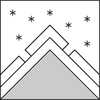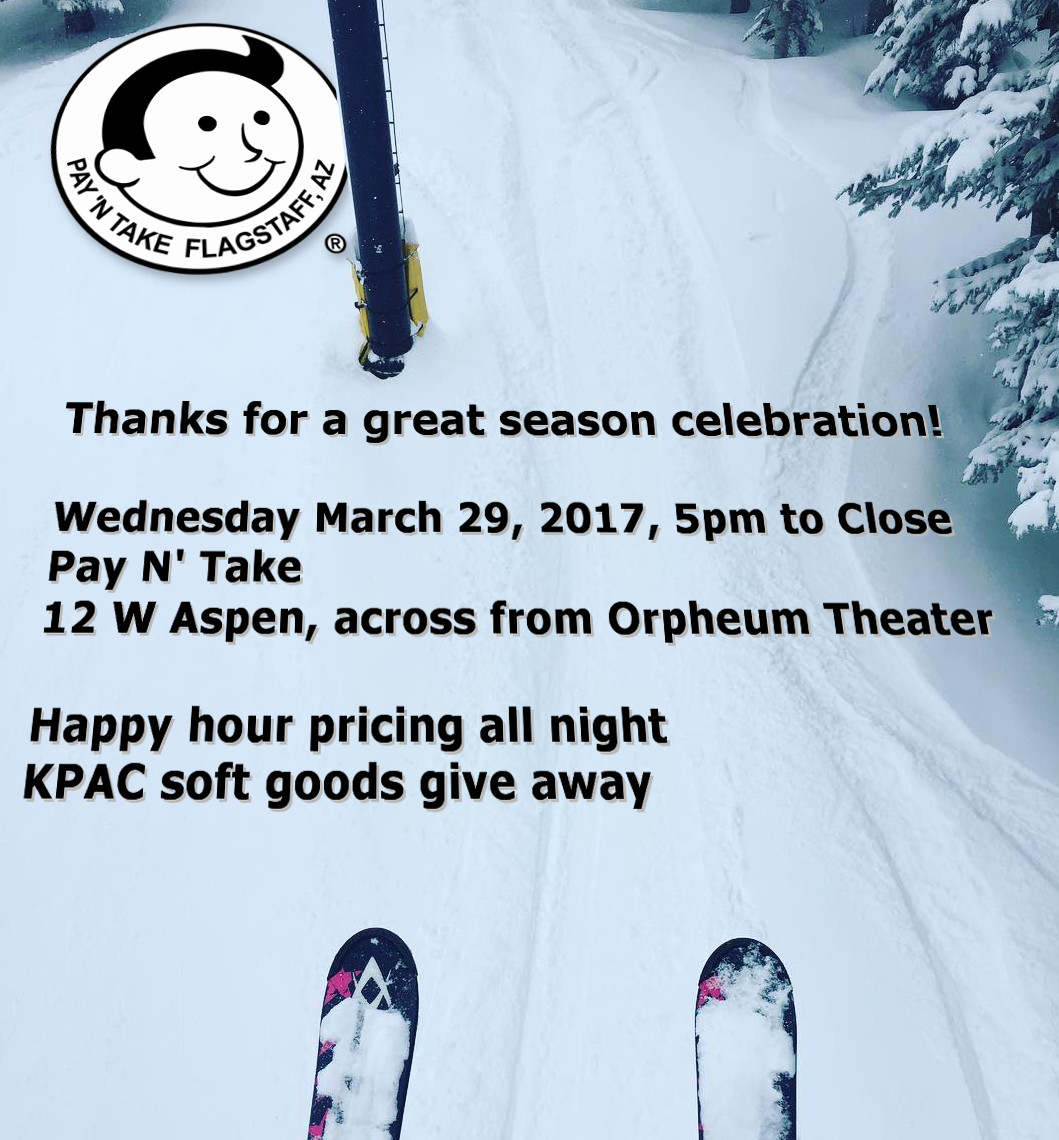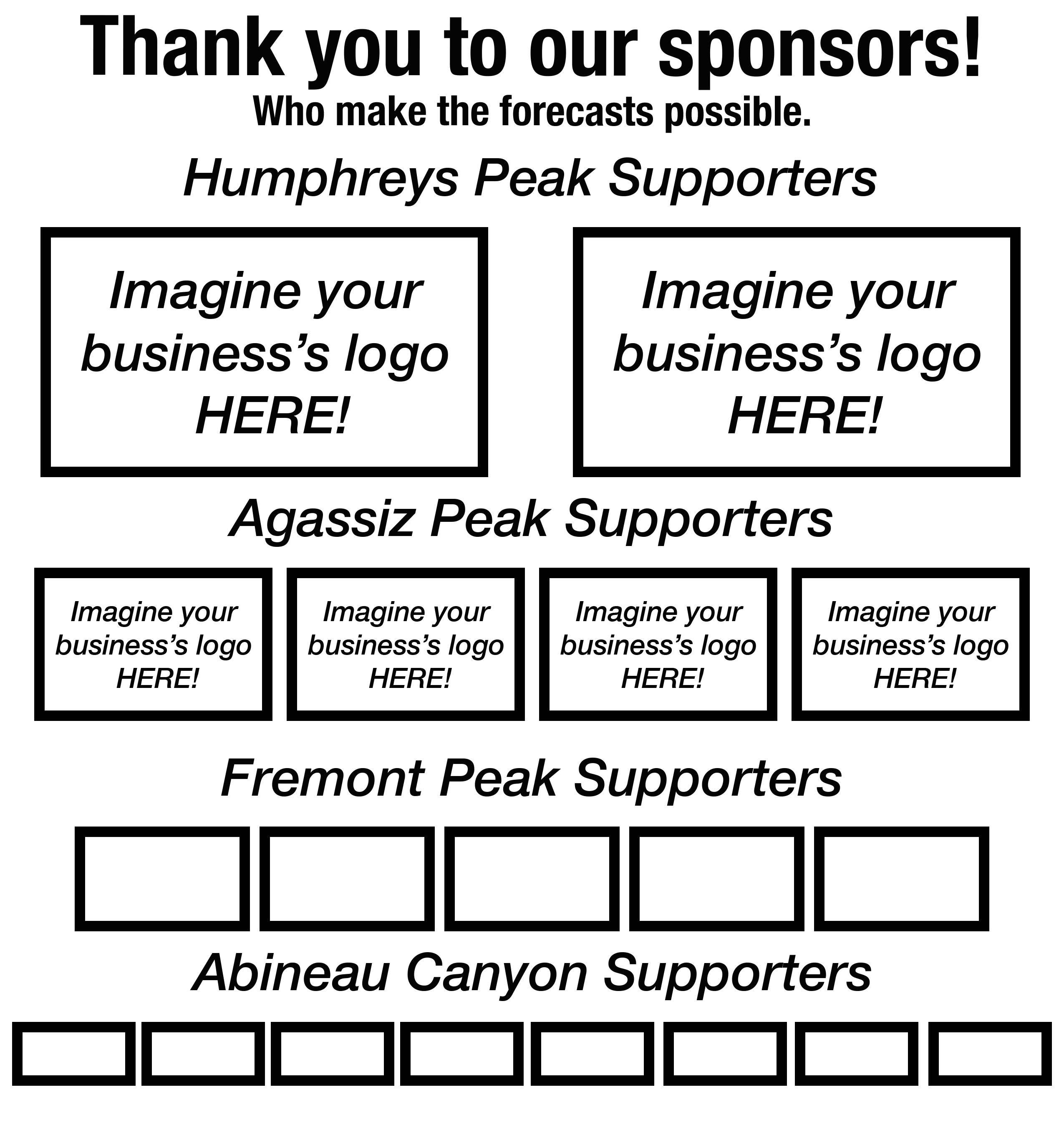Snowpack Summary for Friday, March 24, 2017 6:42 PM Another return to winter conditons
This summary expired Mar. 26, 2017 6:42 PM
Flagstaff, Arizona - Backcountry of The San Francisco Peaks and Kachina Peaks Wilderness
Overall
Fifteen inches of new snow was recorded on mid-mountain at Snowbowl (10,800') on Thursday morning March 23rd.. Over an inch of snow water equivalent (SWE) was recorded for the same period at Snowslide SNOTEL station (9700'). Snow showers and light accumulation continued throughout the day on Thursday adding an additional two to six inches. As a result, storm slab and wind slab avalanche hazard increased. Natural avalanches are possible and human triggered avalanches are likely during the 24-48 hours follow precipitation or wind-transported snow events.
For the short-term, winter travelers are urged to avoid avalanche terrain. Over the upcoming week, skiers and boarders should carefully examine bonding between the new snow and the old, with a critical eye towards identifying a new persistent weak layer of near surface facets that may develop between the new cold snow and old pre-storm snowpack.
For the short-term, winter travelers are urged to avoid avalanche terrain. Over the upcoming week, skiers and boarders should carefully examine bonding between the new snow and the old, with a critical eye towards identifying a new persistent weak layer of near surface facets that may develop between the new cold snow and old pre-storm snowpack.
The pre-storm snowpack gained a lot of heat from unseasonably warm temperatures and high pressure over the past two weeks. Cold snow meeting warm snow will create an environment for rapid facet crystal growth and therefore delayed bonding between new and old snow. This facet creating environment will be most prevalent at high elevations on south and southwest facing slopes where the temperature gradient between new and old will be greatest.
We did get a chance to examine near treeline southwestern slopes on Thursday during the late stages of the storm. The new/old snow boundary was well bonded and not reactive. No collapsing and only very minor cracking in the new snow. However there was a 1.5° C temperature gradient between the new and old snow and this could lead to a weakening of bonds over the next 24 hours. We encourage you to carefully examine the bond between new and old snow.
We did get a chance to examine near treeline southwestern slopes on Thursday during the late stages of the storm. The new/old snow boundary was well bonded and not reactive. No collapsing and only very minor cracking in the new snow. However there was a 1.5° C temperature gradient between the new and old snow and this could lead to a weakening of bonds over the next 24 hours. We encourage you to carefully examine the bond between new and old snow.
Near and Above TreelineNew precipitation is sufficient to cause potential instability. The main issue will be new snow avalanching on the old nearly isothermal snowpack. The magnitude of seriousness of potential slides will be proportional to amount of new snow that has deposited on top of old. Wind transported snow can create slabs much thicker than what's indicated by storm accumulation totals. Wind loading is most likely to be on north, northeast and east facing aspects. As of early Friday morning (3/24), strong northerly winds started transporting snow, potentially loading southerly aspects and cross-loading eastern and western gullies and chutes. Video of north winds by Carlos Danel.
Below TreelineBelow treeline and at lower elevation new snow temperatures are typically warmer, creating a more favorable environment for timely bonding of new snow with the snowpack below. Also, temperature gradients between new snow and old snow will be less dramatic reducing likelihood of significant near surface faceting. Despite the reduced risk of persistent weak layer development, it is still worth carefully examining the boundary between new and old just in case, and thereby avoiding the consequences of being surprised by taking of ride on new snow sliding on the old.
Southerly and westerly aspects below 10,000' are getting thin, with rocks and logs just under the surface and hidden by the recent snow. North and east aspects have fairly good coverage down to 9000'.
Southerly and westerly aspects below 10,000' are getting thin, with rocks and logs just under the surface and hidden by the recent snow. North and east aspects have fairly good coverage down to 9000'.
Current Problems (noninclusive) more info

The development of near surface facets at the boundary of new and old snow could turn a storm slab concern into a persistent slab problem. Especially with the colder treeline temperatures in the forecast.
There is a chance for more snow next week, so storm slab issues may continue.
There is a chance for more snow next week, so storm slab issues may continue.

New snow and wind from the southwest and west during and following Wednesday's storm have created the potentially dangerous wind slab. Storm and post storm wind velocities (20-40 mph) have been idea for the movement of lot of snow. As of early Friday morning (3/24), strong northerly winds started transporting snow, potentially loading southerly aspects and cross-loading eastern and western gullies and chutes. Video of north winds by Carlos Danel.
Always keep in mind, wind slabs are unpredictable, and may support the weight of a skier or rider initially, and fail suddenly with tragic consequences. Avoid snow surfaces which are recently loaded, sound hollow, have signs of fracturing, cracking, or whoompfing sounds.
Images

Thank you for all your support. Come celebrate with us at Pay N’ Take next Wednesday!
Photo by Sabrina Carlson
Final Thoughts
This season numerous rescues have been conducted by Coconino County Search and Rescue, and the Arizona Snowbowl Ski Patrol. Some of these could have been avoided by better planning and preparation.
Travelers are advised to exercise caution, make slope specific evaluations and most of all, know where you are going and be prepared for the unexpected.
As always, please treat this summary with appropriately guarded skepticism, make your own assessments, and contribute to our body of knowledge by reporting your observations.
Arizona Snowbowl uphill policy.
During winter, backcountry permits are required to access the Kachina Peaks Wilderness. More info
Travelers are advised to exercise caution, make slope specific evaluations and most of all, know where you are going and be prepared for the unexpected.
As always, please treat this summary with appropriately guarded skepticism, make your own assessments, and contribute to our body of knowledge by reporting your observations.
Arizona Snowbowl uphill policy.
During winter, backcountry permits are required to access the Kachina Peaks Wilderness. More info
Weather
Last updated on Friday, March 24, 2017
After two weeks high pressure and spring conditions, Wednesday and Thursday brought a surprisingly potent storm with 18-23 inches of new snow to high elevations on San Francisco Peaks. The storm was accompanied by moderately sustained winds out of the west and southwest, with gusts recorded into the high 40s (mph). On Friday March 24th, northerly winds and intensified, with lots of snow observed being transported in turbulent suspension across ridge lines. Temperatures on Friday will warm briefly, before a short wave trough passes quickly through our region on Saturday bringing light to moderate precipitation to the high courtly. Throughout the rest of the week, the weather will be breezy, unsettled, and more reflective of seasonally average temperatures.
On Friday morning, March 24th the Inner Basin SNOTEL site (Snowslide) reported a snow depth of 72 inches (183 cm) at 9700' and Arizona Snowbowl reported 103 inches (262 cm) at 10800'. Since March 17th SNOTEL temperatures ranged between 24° and 58° F and Agassiz station between 13° and 49° F.
After two weeks high pressure and spring conditions, Wednesday and Thursday brought a surprisingly potent storm with 18-23 inches of new snow to high elevations on San Francisco Peaks. The storm was accompanied by moderately sustained winds out of the west and southwest, with gusts recorded into the high 40s (mph). On Friday March 24th, northerly winds and intensified, with lots of snow observed being transported in turbulent suspension across ridge lines. Temperatures on Friday will warm briefly, before a short wave trough passes quickly through our region on Saturday bringing light to moderate precipitation to the high courtly. Throughout the rest of the week, the weather will be breezy, unsettled, and more reflective of seasonally average temperatures.
On Friday morning, March 24th the Inner Basin SNOTEL site (Snowslide) reported a snow depth of 72 inches (183 cm) at 9700' and Arizona Snowbowl reported 103 inches (262 cm) at 10800'. Since March 17th SNOTEL temperatures ranged between 24° and 58° F and Agassiz station between 13° and 49° F.
Authored/Edited By: Derik Spice, David Lovejoy, Troy Marino







